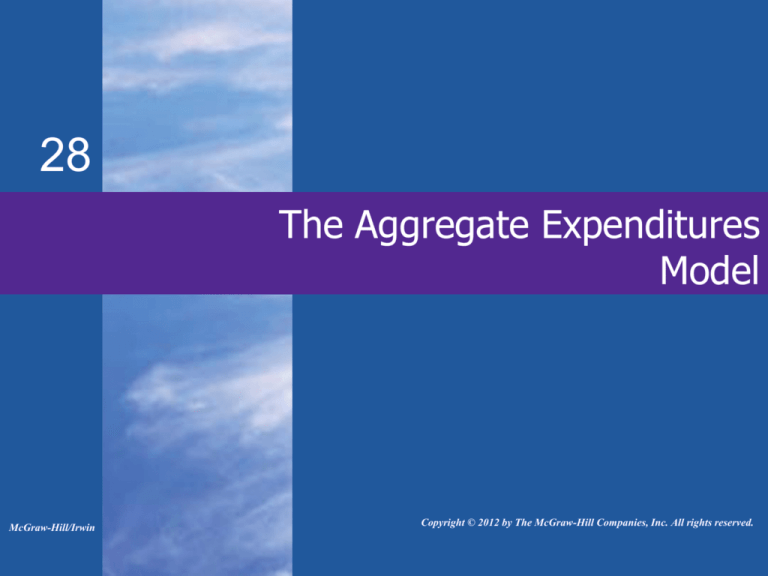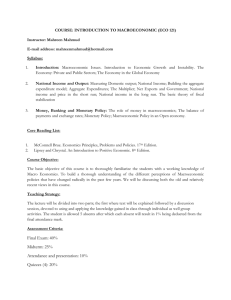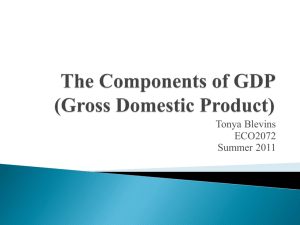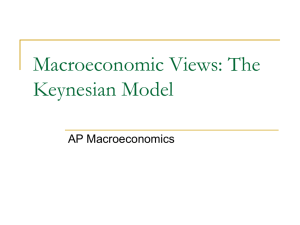
28
The Aggregate Expenditures
Model
McGraw-Hill/Irwin
Copyright © 2012 by The McGraw-Hill Companies, Inc. All rights reserved.
The Aggregate Expenditures Model
Learning objectives – After reading this chapter, students
should be able to:
1.Illustrate how economists combine consumption and
investment to depict an aggregate expenditures schedule for a
private closed economy.
2.Discuss the three characteristics of the equilibrium level of
real GDP in a private closed economy:
– aggregate expenditures = output;
– saving = investment; and
– no unplanned changes in inventories.
3.Analyze how changes in equilibrium real GDP can occur in
the aggregate expenditures model and describe how those
changes relate to the multiplier.
28-2
The Aggregate Expenditures Model
4.Explain how economists integrate the public sector
(government expenditures and taxes) and the international
sector (exports and imports) into the aggregate expenditures
model.
5.Identify and describe the nature and causes of “recessionary
expenditure gaps” and “inflationary expenditure gaps.”
28-3
The Aggregate Expenditures Model
• Assumptions and Simplifications
• Keynes developed the aggregate expenditures model during the
Great Depression because previous economic theory predicted
that prices would fall to boost spending and move the economy to
full-employment.
• Prices did not fall sufficiently during the Great Depression.
• Keynes’ model is based on fixed prices and the adjustment of
employment and GDP to economic shocks when prices are
inflexible.
• We first assume a “closed economy” with no international trade.
• Government is ignored.
• Although both households and businesses save, we assume here
that all saving is personal.
• Depreciation and net foreign income are assumed to be zero for
simplicity.
28-4
The Aggregate Expenditures Model
• There are two reminders concerning these assumptions.
1. They leave out two key components of aggregate demand
(government spending and foreign trade), because they are
largely affected by influences outside the domestic market
system.
2. With no government or foreign trade, GDP, national income
(NI), personal income (PI), and disposable income (DI) are all
the same.
28-5
The Aggregate Expenditures Model
• Consumption and Investment Schedules
• The theory assumes that the level of output and employment
depend directly on the level of aggregate expenditures.
Changes in output reflect changes in aggregate spending.
• In a closed private economy the two components of
aggregate expenditures are consumption and gross
investment.
• In addition to the investment demand schedule, economists
also define an investment schedule that shows the amounts
business firms collectively intend to invest at each possible
level of GDP or DI.
28-6
The Aggregate Expenditures Model
• In developing the investment schedule, it is assumed that
investment is independent of the current income. The line Ig
(gross investment) in Figure 31.1b shows this graphically
related to the level determined by Figure 31.1a.
• The assumption that investment is independent of income is
a simplification, but will be used here.
• Figure 31.1a shows the investment schedule from GDP
levels given in Table 30.1.
28-7
The Aggregate Expenditures Model
Investment
demand
curve
8
20
ID
20
Investment
(billions of dollars)
(a)
Investment demand curve
Investment Schedule
Investment (billions of dollars)
r and i (percent)
Investment Demand Curve
Investment
schedule
Ig
20
20
Real domestic product, GDP
(billions of dollars)
(b)
Investment schedule
28-8
The Aggregate Expenditures Model
• IV. Equilibrium GDP: C+Ig = GDP
• Look at Table 31.2, which combines data of Tables 30.1 and
31.1.
• Real domestic output in column 2 shows ten possible levels
that producers are willing to offer, assuming their sales
would meet the output planned. In other words, they will
produce $370 billion of output if they expect to receive $370
billion in revenue.
• Ten levels of aggregate expenditures are shown in column 6.
The column shows the amount of consumption and planned
gross investment spending (C + Ig) forthcoming at each
output level.
28-9
Equilibrium GDP
Determination of the Equilibrium Levels of Employment, Output, and Income: A Private Closed Economy
(2)
Real
Domestic
Output
(and
Income)
(GDP =
DI),*Billion
s
(3)
Consumption
(C),
Billions
(4)
Saving
(S),
Billions
(1) 40
$370
$375
(2) 45
390
(3) 50
(1)
Possible
Levels of
Employment,
Millions
(5)
Investment
(Ig),
Billions
(6)
Aggregate
Expenditure
(C+Ig),
Billions
(7)
Unplanned
Changes in
Inventories,
(+ or -)
(8)
Tendency of
Employment,
Output, and
Income
$-5
$20
$395
$-25
Increase
390
0
20
410
-20
Increase
410
405
5
20
425
-15
Increase
(4) 55
430
420
10
20
440
-10
Increase
(5) 60
450
435
15
20
455
-5
Increase
(6) 65
470
450
20
20
470
0
(7) 70
490
465
25
20
485
+5
Decrease
(8) 75
510
480
30
20
500
+10
Decrease
(9) 80
530
495
35
20
515
+15
Decrease
(10) 85
550
510
40
20
530
+20
Decrease
Equilibrium
* If depreciation and net foreign factor income are zero, government is ignored and it is assumed that all saving occurs in the household sector of the economy,
then GDP as a measure of domestic output is equal to NI,PI, and DI. Household income = GDP
28-10
Aggregate expenditures, C + Ig (billions of dollars)
Equilibrium GDP
530
C + Ig
(C + Ig = GDP)
510
490
470
450
Equilibrium
point
Aggregate
expenditures
C
Ig = $20 billion
430
410
390
C = $450 billion
370
45°
370 390 410 430 450 470 490 510 530 550
Real domestic product, GDP (billions of dollars)
28-11
The Aggregate Expenditures Model
• Recall that consumption level is directly related to the level of
income and that here income is equal to output level.
• Investment is independent of income here and is planned or
intended regardless of the current income situation.
• Equilibrium GDP is the level of output whose production will
create total spending just sufficient to purchase that output.
Otherwise there will be a disequilibrium situation.
• 1. In Table 31.2, this occurs only at $470 billion.
• 2. At $410 billion GDP level, total expenditures (C + Ig)
would be $425 = $405(C) + $20 (Ig) and businesses will
adjust to this excess demand (revealed by the declining
inventories) by stepping up production. They will expand
production at any level of GDP less than the $470 billion
equilibrium.
28-12
The Aggregate Expenditures Model
• 3. At levels of GDP above $470 billion, such as $510 billion,
aggregate expenditures will be less than GDP. At $510 billion
level, C + Ig = $500 billion. Businesses will have unsold,
unplanned inventory investment and will cut back on the rate of
production. As GDP declines, the number of jobs and total
income will also decline, but eventually the GDP and aggregate
spending will be in equilibrium at $470 billion.
• Graphical analysis is shown in Figure 31.2 (Key Graph). At $470
billion it shows the C + Ig schedule intersecting the 45-degree line
which is where output = aggregate expenditures, or the
equilibrium position.
• 1. Observe that the aggregate expenditures line rises with output
and income, but not as much as income, due to the marginal
propensity to consume (the slope) being less than 1. A part of
every increase in disposable income will not be spent but will be
saved.
28-13
The Aggregate Expenditures Model
• Other Features of Equilibrium GDP
• Savings equals planned investment.
• It is important to note that in our analysis above we spoke of
“planned” investment. At GDP = $470 billion in Table 31.2,
both saving and planned investment are $20 billion.
• Saving represents a “leakage” from spending stream and
causes C to be less than GDP.
• Some of output is planned for business investment and not
consumption, so this investment spending can replace the
leakage due to saving.
28-14
The Aggregate Expenditures Model
• If aggregate spending is less than equilibrium GDP as it is in Table
31.2, line 8 when GDP is $510 billion, then businesses will find
themselves with unplanned inventory investment on top of what
was already planned. This unplanned portion is reflected as a
business expenditure, even though the business may not have
desired it, because the total output has a value that belongs to
someone—either as a planned purchase or as an unplanned
inventory.
• If aggregate expenditures exceed GDP, then there will be less
inventory investment than businesses planned as businesses sell
more than they expected. This is reflected as a negative amount
of unplanned investment in inventory. For example, at $450 billion
GDP, there will be $435 billion of consumer spending, $20 billion
of planned investment, so businesses must have experienced a
$5 billion unplanned decline in inventory because sales exceed
that expected.
28-15
The Aggregate Expenditures Model
• No unplanned changes in inventories.
• Consider row 7 of Table 31.2 where GDP is $490 billion,
here C + Ig is only $485 billion and will be less than output
by $5 billion. Firms retain the extra $5 billion as unplanned
inventory investment. Actual investment is $25 billion, or $5
billion more than the $20 billion planned. So $490 billion is
an above-equilibrium output level.
• Consider row 5, Table 31.2. Here $450 billion is a belowequilibrium output level because actual investment will be $5
billion less than planned. Inventories decline below what
was planned. GDP will rise to $470 billion.
28-16
The Aggregate Expenditures Model
• Changes in Equilibrium GDP and the Multiplier
• As developed in Chapter 30, an initial change in spending
will be acted on by the multiplier to produce larger changes
in output.
• 1. The “initial change” represented in the text and Figure
31.3 is in planned investment spending. It could also result
from a nonincome-induced change in consumption.
• 2. The multiplier in Figure 31.3 is 4 (=1/MPS)
• Figure 31.3 shows the impact of changes in investment.
Suppose investment spending rises (due to a rise in profit
expectations or to a decline in interest rates).
28-17
The Aggregate Expenditures Model
• Figure 31.3 shows the increase in aggregate expenditures
from (C + Ig)0 to (C + Ig)1. In this case, the $5 billion
increase in investment leads to a $20 billion increase in
equilibrium GDP.
• Conversely, a decline in investment spending of $5 billion is
shown to create a decrease in equilibrium GDP of $20 billion
to $450 billion.
28-18
Aggregate expenditures (billions of dollars)
Changes in Equilibrium GDP
(C + Ig)1
(C + Ig)0
(C + Ig)2
510
490
Increase in
investment
470
Decrease in
investment
450
430
45°
430
450
470
490
510
Real domestic product, GDP (billions of dollars)
28-19
The Aggregate Expenditures Model
• International Trade and Equilibrium Output
• A. Net exports (exports minus imports) affect aggregate
expenditures in an open economy. Exports expand and
imports contract aggregate spending on domestic output.
• Exports (X) create domestic production, income, and
employment due to foreign spending on U.S. produced
goods and services.
• Imports (M) reduce the sum of consumption and investment
expenditures by the amount expended on imported goods,
so this figure must be subtracted so as not to overstate
aggregate expenditures on U.S. produced goods and
services.
28-20
The Aggregate Expenditures Model
• The net export schedule (Table 31.3):
• Shows hypothetical amount of net exports (X - M) that will
occur at each level of GDP given in Table 31.2.
• Assumes that net exports are autonomous or independent of
the current GDP level.
• Figure 31.4b shows Table 31.3 graphically.
– a. Xn1 shows a positive $5 billion in net exports.
– b. Xn2 shows a negative $5 billion in net exports.
28-21
The Net Export Schedule
Two Net Export Schedules (in Billions)
(1)
Level of GDP
(2)
Net Exports,
Xn1 (X > M)
(3)
Net Exports,
Xn2 (X < M)
$370
$+5
$-5
390
+5
-5
410
+5
-5
430
+5
-5
450
+5
-5
470
+5
-5
490
+5
-5
510
+5
-5
530
+5
-5
550
+5
-5
28-22
Net Exports and Equilibrium GDP
C + Ig+Xn1
C + Ig
C + Ig+Xn2
Aggregate expenditures
(billions of dollars)
510
Aggregate expenditures
490 with positive
net exports
Aggregate expenditures
with negative net
exports
470
450
430
45°
Net exports, Xn
(billions of
dollars)
430
450
470
490
510
Real domestic product GDP (billions of dollars)
+5
0
-5
Positive net exports
450
470
Negative net exports
Xn1
490
Xn2
Real
GDP
28-23
The Aggregate Expenditures Model
• The impact of net exports on equilibrium GDP is illustrated in
Figure 31.4a.
• Positive net exports increase aggregate expenditures
beyond what they would be in a closed economy and thus
have an expansionary effect. The multiplier effect also is at
work. In Figure 31.4a we see that positive net exports of $5
billion lead to a positive change in equilibrium GDP of $20
billion (to $490 from $470 billion). This comes from Table
31.2 and Figure 31.3.
• Negative net exports decrease aggregate expenditures
beyond what they would be in a closed economy and thus
have a contractionary effect. The multiplier effect also is at
work here. In Figure 31.4a we see that negative net exports
of $5 billion lead to a negative change in equilibrium GDP of
$20 billion (to $450 from $470 billion).
28-24
The Aggregate Expenditures Model
• Global Perspective 31.1 shows 2008 net exports for various
nations.
• International economic linkages:
• 1. Prosperity abroad generally raises our exports and
transfers some of their prosperity to us. (Conversely,
recession abroad has the reverse effect.)
• 2. Depreciation of a nation’s currency unit lowers the cost of
that nation’s goods to foreigners and encourages exports
from the nation while discouraging the purchase of imports in
the nation. This could lead to higher real GDP or to inflation,
depending on the domestic employment situation.
Appreciation of a nation’s currency unit could have the
opposite impact.
28-25
The Aggregate Expenditures Model
•
Nations must be cautious when using tariffs and
devaluations in an effort to increase their net exports and
therefore their domestic employment and output. When
other nations’ exports are restricted, they may retaliate,
reducing exports and actually causing net exports to fall.
This happened during the U.S. Great Depression.
28-26
Global Perspective
Source: World Trade Organization, http://www.wto.org.
28-27
The Aggregate Expenditures Model
• Adding the Public Sector
• A. Simplifying assumptions are helpful for clarity when we
include the government sector in our analysis. (Many of
these simplifications are dropped in Chapter 33, where there
is further analysis on the government sector.)
• Simplified the investment and net export schedules that are
used. We assume they are independent of the level of
current GDP.
• We assume government purchases do not impact private
spending schedules.
• We assume that net tax revenues are derived entirely from
personal taxes so that GDP, NI, and PI remain equal. DI is
PI minus net personal taxes.
28-28
The Aggregate Expenditures Model
• We assume tax collections are independent of GDP level (a
lump-sum tax)
• The price level is assumed to be constant unless otherwise
indicated.
• Table 31.4 gives a tabular example of including $20 billion in
government spending and Figure 31.5 gives the graphical
illustration. Note that the previous section’s net export
information has also been included.
• Increases in government spending boost aggregate
expenditures.
• Government spending is subject to the multiplier.
• Table 31.5 and Figure 31.6 show the impact of a tax
increase.
28-29
Government Purchases and Eq. GDP
The Impact of Government Purchases on Equilibrium GDP
(1)
Real
Domestic
Output and
Income
(GDP=DI),
Billions
(5)
Net Exports
(Xn), Billions
Imports
(M)
(6)
Government
Purchases
(G), Billions
(7)
Aggregate
Expenditures
(C+Ig+Xn+G),
Billions
(2)+(4)+(5)+(6)
$10
$10
$20
$415
20
10
10
20
430
5
20
10
10
20
445
420
10
20
10
10
20
460
(5) 450
435
15
20
10
10
20
475
(6) 470
450
20
20
10
10
20
490
(7) 490
465
25
20
10
10
20
505
(8) 510
480
30
20
10
10
20
520
(9) 530
495
35
20
10
10
20
535
(10) 550
510
40
20
10
10
20
550
(2)
Consumption
(C),
Billions
(3)
Saving (S),
Billions
(4)
Investment
(Ig),
Billions
Exports
(X)
(1) $370
$375
$-5
$20
(2) 390
390
0
(3) 410
405
(4) 430
28-30
Aggregate expenditures (billions of dollars)
Government Purchases and Eq. GDP
C + Ig + Xn + G
C + Ig + X n
C
Government spending
of $20 billion
45°
470
550
Real domestic product, GDP (billions of dollars)
28-31
The Aggregate Expenditures Model
• Taxes reduce DI and, therefore, consumption and saving at
each level of GDP.
• An increase in taxes will lower the aggregate expenditures
schedule relative to the 45-degree line and reduce the
equilibrium GDP.
• Table 31.5 confirms that, at equilibrium GDP, the sum of
leakages equals the sum of injections. Saving + Imports +
Taxes = Investment + Exports + Government Purchases.
• Government purchases and taxes have different impacts.
• In our example, equal additions in government spending and
taxation increase the equilibrium GDP.
• If G and T are each increased by a particular amount, the
equilibrium level of real output will rise by that same amount.
28-32
The Aggregate Expenditures Model
• an increase of $20 billion in G and an offsetting increase of
$20 billion in T will increase equilibrium GDP by $20 billion
(from $470 billion to $490 billion).
• An increase in G is direct and adds $20 billion to aggregate
expenditures.
• An increase in T has an indirect effect on aggregate
expenditures because T reduces disposable incomes first,
and then C falls by the amount of the tax times MPC.
• The overall result is a rise in initial spending of $20 billion
minus a fall in initial spending of $15 billion (.75 ¥ $20
billion), which is a net upward shift in aggregate
expenditures of $5 billion. When this is subject to the
multiplier effect, which is 4 in this example, the increase in
GDP will be equal to 4 x $5 billion or $20 billion, which is the
size of the change in G.
28-33
Taxation and Equilibrium GDP
Determination of the Equilibrium Levels of Employment, Output, and Income: Private and Public Sectors
(1)
Real
Domestic
Output
and
Income
(GDP=DI),
Billions
(7)
Net Exports
(Xn), Billions
(9)
Aggregate
Expenditures
(C+Ig+Xn
+G),
Billions
(4)+(6)+(7)
+(8)
(2)
Taxes
(T),
Billions
(3)
Disposable
Income
(DI),
Billions,
(1)-(2)
(4)
Consumption (C),
Billions
(5)
Saving
(S),
Billions
(6)
Investment (Ig),
Billions
Export
s
(X)
Import
s
(M)
(8)
Government
Purchases
(G),
Billions
(1) $370
$20
$350
$360
$-10
$20
$10
$10
$20
$400
(2) 390
20
370
375
-5
20
10
10
20
415
(3) 410
20
390
390
0
20
10
10
20
430
(4) 430
20
410
405
5
20
10
10
20
445
(5) 450
20
430
420
10
20
10
10
20
460
(6) 470
20
450
435
15
20
10
10
20
475
(7) 490
20
470
450
20
20
10
10
20
490
(8) 510
20
490
465
25
20
10
10
20
505
(9) 530
20
510
480
30
20
10
10
20
520
(10) 550
20
530
495
35
20
10
10
20
535
28-34
Aggregate expenditures (billions of dollars)
Taxation and Equilibrium GDP
C + Ig + Xn + G
Ca + Ig + Xn + G
$15 billion
decrease in
consumption
from a
$20 billion
increase
in taxes
45°
490
550
Real domestic product, GDP (billions of dollars)
28-35
The Aggregate Expenditures Model
• Equilibrium revisited
• As demonstrated earlier, in a closed private economy
equilibrium occurs when saving (a leakage) equals planned
investment (an injection).
• With the introduction of a foreign sector (net exports) and a
public sector (government), new leakages and injections are
introduced.
• Imports and taxes are added leakages.
• Exports and government purchases are added injections.
• Equilibrium is found when the leakages equal the injections.
28-36
The Aggregate Expenditures Model
• When leakages equal injections, there are no unplanned
changes in inventories.
• Symbolically, equilibrium occurs when
Sa + M + T = Ig + X + G,
• where Sa is after-tax saving, M is imports, T is taxes, Ig is
(gross) planned investment, X is exports, and G is
government purchases.
28-37
The Aggregate Expenditures Model
• Equilibrium vs. Full-Employment GDP
• A recessionary expenditure gap exists when equilibrium
GDP is below full-employment GDP. (See Key Graph 31.7a)
• Recessionary expenditure gap of $5 billion is the amount by
which aggregate expenditures fall short of those required to
achieve the full-employment level of GDP.
• In Table 31.5, assuming the full-employment GDP is $510
billion, the corresponding level of total expenditures there is
only $505 billion. The gap would be $5 billion, the amount
by which the schedule would have to shift upward to realize
the full-employment GDP.
28-38
The Aggregate Expenditures Model
• Graphically, the recessionary expenditure gap is the vertical
distance by which the aggregate expenditures schedule (Ca
+ Ig + Xn + G)1 lies below the full-employment point on the
45-degree line.
• Because the multiplier is 4, we observe a $20-billion
differential (the recessionary gap of $5 billion times the
multiplier of 4) between the equilibrium GDP and the fullemployment GDP.
• An inflationary expenditure gap exists when aggregate
expenditures exceed full-employment GDP.
• Figure 31.7b shows that a demand-pull inflationary
expenditure gap of $5 billion exists when aggregate
spending exceeds what is necessary to achieve full
employment.
28-39
The Aggregate Expenditures Model
• The inflationary expenditure gap is the amount by which the
aggregate expenditures schedule must shift downward to
realize the full-employment noninflationary GDP.
• The effect of the inflationary expenditure gap is to pull up the
prices of the economy’s output.
• In this model, if output can’t expand, pure demand-pull
inflation will occur.
28-40
Aggregate expenditures
(billions of dollars)
Equilibrium versus Full-Employment
AE0
AE1
530
510
Recessionary
expenditure
gap = $5 billion
490
Full
employment
45°
490
510
530
Real GDP
(a)
Recessionary expenditure gap
LO5
Aggregate expenditures
(billions of dollars)
Equilibrium versus Full-Employment
AE2
530
Inflationary
expenditure
gap = $5 billion
AE0
510
490
Full
employment
45°
490
510
530
Real GDP
(b)
(billions of dollars)
LO5
The Aggregate Expenditures Model
• Application: The Recession of 2007 – 2009
• The U.S. economy entered a recession in December 2007
• After-tax consumption and planned investment both
decreased with a much greater fall in investment.
• Aggregate expenditures decreased (shifted down), creating
the largest recessionary expenditures gap since the Great
Depression.
• Unemployment rate increased to more than 10%.
• The U.S. government adopted Keynesian policies in 2008
and 2009.
• In 2008 the U.S. Federal government provided $100 billion in
tax rebate checks, hoping to increase consumption and
aggregate expenditures, but most people paid off their debt
and there was not any increase in aggregate expenditures.
28-43
The Aggregate Expenditures Model
• In 2009 the U.S. Federal government passed a $787 billion
stimulus package with large increases in government
spending to try to increase aggregate expenditures, increase
GDP and increase employment.
• Greater evaluation of these policies will take place in
Chapter 33.
28-44
The Aggregate Expenditures Model
•
LAST WORD: Say’s Law, The Great Depression, and
Keynes
• Until the Great Depression of the 1930, most economists
going back to Adam Smith had believed that a market
system would ensure full employment of the economy’s
resources except for temporary, short-term upheavals.
• If there were deviations, they would be self-correcting. A
slump in output and employment would reduce prices, which
would increase consumer spending; would lower wages,
which would increase employment again; and would lower
interest rates, which would expand investment spending.
• Say’s law, attributed to the French economist J. B. Say in the
early 1800s, summarized the view in a few words: “Supply
creates its own demand.”
28-45
The Aggregate Expenditures Model
• Say’s law is easiest to understand in terms of barter. The
woodworker produces furniture in order to trade for other
needed products and services. All the products would be
traded for something, or else there would be no need to
make them. Thus, supply creates its own demand.
• Reformulated versions of these classical views are still
prevalent among some modern economists today.
• The Great Depression of the 1930s was worldwide. GDP fell
by 40 percent in U.S. and the unemployment rate rose to
nearly 25 percent (when most families had only one
breadwinner). The Depression seemed to refute the
classical idea that markets were self-correcting and would
provide full employment.
28-46
The Aggregate Expenditures Model
• John Maynard Keynes in 1936 in his General Theory of
Employment, Interest, and Money, provided an alternative to
classical theory, which helped explain periods of recession.
• Not all income is always spent, contrary to Say’s law.
• Producers may respond to unsold inventories by reducing output
rather than cutting prices.
• A recession or depression could follow this decline in employment
and incomes.
• The modern aggregate expenditures model is based on
Keynesian economics or the ideas that have arisen from Keynes
and his followers since. It is based on the idea that saving and
investment decisions may not be coordinated, and prices and
wages are not very flexible downward. Internal market forces can
therefore cause depressions and government should play an
active role in stabilizing the economy.
28-47
The Aggregate Expenditures Model
LO1
28-48









